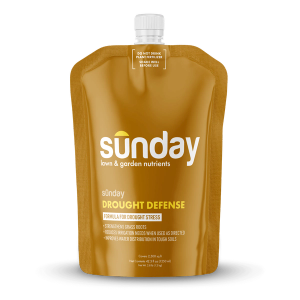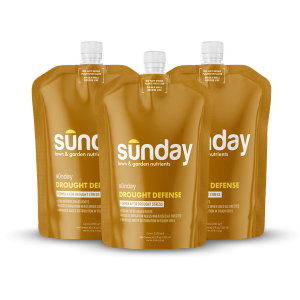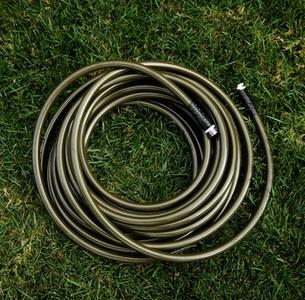Picking the right tools
Selecting tools for lawn care isn’t as easy as receiving your customized smart lawn plan. At Sunday, we really mean it when we say we’re here to keep your lawn care routine as easy, efficient, and enjoyable as possible. So, we’ve crafted an equipment guide with top recommendations to help you do just that.
Explore protective, manual, irrigation, and power equipment carefully curated to help you:
- Select tools that are easy to use
- Reduce input and emissions to your yard ecosystem
- Conserve natural resources and help the environment
- Maintain a hands-on approach to working with the land
- Get multiple applications out of a tool - it’s not just for lawns!
Protective equipment
First things first, protect yourself! When you’re outside mowing the lawn or tidying up the yard, make sure to wear the right gear. Protective equipment for lawn care includes gloves, long pants, long sleeves, close-toed shoes, ear (if using power tools), and sun protection (hat, sunscreen, bandana or neck gaiter).
Manual equipment
Maintain your hands-on approach to lawn care with manual lawn equipment. Not only are these better for the environment, but they’re also effective tools to help spread grass seed correctly, patch bare spots, manage weeds effectively, and ultimately, encourage a lush, green lawn. Keep it to just the essentials with five must-haves:
Hand weeder
Primarily used for its namesake—weeding—this multifunctional tool can be repurposed for seeding prep, testing compaction, and gardening. Consider grip and weeder style for tool selection.
Handclipper or pruner
Use this multifunctional tool for lawn care to snip grasses and manage weeds. Plus, use throughout the garden to deadhead, prune, trim, weed, and collect cut flowers, fruits, or vegetables.
Seed spreader
Spread grass seed uniformly and at the right distribution to avoid wasteful seeding applications and maintain efficiency in your seeding regimen. Select a seed spreader that’s the right size for you and can handle distribution amounts for your yard.
Cultivator
Cultivators help prep the soil to plant, seed, and break up minor soil compaction; they can also be useful for removing stubborn weeds and helping prep garden beds. Select a cultivator that’s intended to be used while standing and determine if your lawn size requires one.
Rake
A rake is a perfect tool to topdress soil, lightly remove thatch or matted grass, distribute grass clippings, or simply tidy up the yard and garden. Select the right size, metal or plastic preferences, and choose a sturdy rake that’ll last.
Irrigation equipment
Watering your lawn correctly is essential to growing dense turf that outcompetes weeds. Sunday’s guide to irrigation equipment intends to help you irrigate properly while conserving our greatest natural resource. But before jumping into a pool of watering equipment, learn how to avoid common watering mistakes, prep your sprinkler, identify signs of improper watering, and conserve water in your lawn.
Hose: 50 ft or 100 ft
A hose is essential for applying Sunday nutrients, patching bare spots, rinsing pet spots, and gardening in general. For this tool, the most important purchase consideration will be the size of your lawn: 50 ft. for smaller lawns, 100 ft. for larger lawns.
Hose and sprinkler attachments
Hose attachments and sprinkler attachments provide targeted watering so minimal amounts of water are wasted when used properly. This type of watering system is recommended for the Eastern divide of the U.S.
Sunday Tip: The sprinkler attachment recommended has a throw of up to 43 ft. and covers up to 5000 sq. ft. If you have a larger lawn (over 5000 sq. ft.), you will need to move to cover the entire lawn.
In-ground watering system
In-ground irrigation allows for uniform watering on a set schedule, and options to adjust to conserve water and abide by local water restrictions. Make sure to utilize a reputable irrigation installer for installation and repairs. This type of watering system makes the most sense in the Western divide of the U.S, and we recommend this system if you have a 5,000+ sq. ft. lawn.
5-piece watering gauge kit
Gauge kits check for uniform watering and help determine the cover, reach, and throw of your watering system. Whether you use a sprinkler attachment or in-ground system, this kit is key to watering properly, avoiding over or underwatering, and helping conserve water.
Simple timer for hose
Water your lawn in the correct timeframe and shut off watering systems with a simple timer. This tool makes your lawn routine easier, improves watering practices, and helps to conserve water.
Power equipment
We’re putting a stop to traditionally fueled lawn care. Limit inputs to your lawn, and lower carbon emissions in your yard with Sunday’s list of battery-operated or electric-powered equipment. But remember, power is not just in the way you purchase—it's embedded in proper use, upkeep, technique, and annual maintenance.
Lawn mower
Mowing your lawn is obvious, but beyond cutting your grass, a mower can also help manage weeds, reintroduce nutrients from grass clippings and fall leaves to your lawn, and assist with seeding come fall.
Sunday Tip: Did you know every hour running a fuel-powered lawn mower is like driving from Chicago to LA? Yep, that’s why we will always recommend battery-operated and electric over fuel engines.
Hand trimmers and line trimmers
For managing lawn perimeters, hard-to-cut areas, weeds poking through sidewalks, and managing landscape needs, hand trimmers and line trimmers can’t be beat. Helpful tip? Line trimmers tend to be easier to use than hand trimmers.
Battery-operated blower
When used properly, this lawn tool moves unwanted natural debris, spreads out grass clippings, and helps manage fall leaves—simplifying lawn your spring and fall lawn maintenance.
Sunday Tip: Avoiding blowing leaves into the street and help limit phosphorus pollution whenever possible
Cited sources
Stocking the Toolshed: Hand Tools. University of Georgia Extension.














